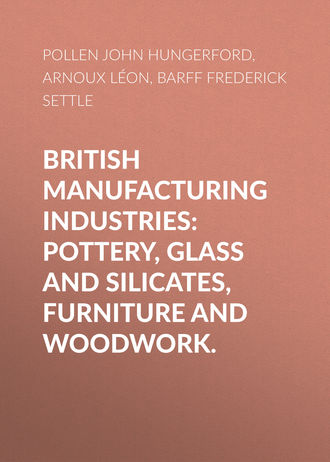 полная версия
полная версияBritish Manufacturing Industries: Pottery, Glass and Silicates, Furniture and Woodwork.
Objects of this kind, though fragmentary, or slightly worked out, or combined in some grotesque but graceful fashion, with a piece of leaf or stalk, are the easy results of long years of mental and manual training.
The workman artist, therefore, though his productions may not be thought suitable for the Academy walls, is a child of the same school, as that which brings forth such portents as Phidias, Praxiteles, Michael Angelo, and Leonardo, not to speak of our Royal Academicians.
Artists who are "specialists," like Giovanni da Udine, will continue to do special things only, but those admirably. Where the arts flourish, there will be a large school that includes half a nation, artists of all ranges of education, refinement, and knowledge. Some will sculpture figures for the temple, others will be of the rank of workmen. Vasari has given full details of the sumptuous furniture which was executed by the sixteenth century Academicians of Florence.
How are we to procure such teachings? This was the question which Colbert put to himself in the reign of Louis XIV. He resolved it, by getting masters and teachers of every kind of sumptuary art from Italy. The result has been to give the French nation a lead in this kind of industry, that holds good even amidst the ruin of old traditions, at this day.
The Kensington schools, and those on the same pattern throughout the country, are efforts made by the Government to meet the wants of our manufacturers. They are inelastic, and it is too soon to judge of the work they are likely to do hereafter. The only great error in such education would be to train scholars to be "ornamentalists," i.e. to teach them conventional art.
Art is conventional in connection with architecture and furniture, because in most instances this is all that would be proper or look well. A good modeller, draughtsman, or carver, would become conventional just as occasion required, but with no abstract desire for ugliness or the grotesque. That artists should be generally well educated and good scholars, and that the profession should possess knowledge and refinement, is of more importance than most people suppose. This kind of refinement lay at the root of the universality of accomplishments of the sixteenth century artists.
Lastly, it is not enough that the profession only should be educated, so as to supply the manufacturer with designs. It is the rich that must be taught as well. We are neither Italians nor Frenchmen, and, indeed, speaking generally, we have not so much sense of beauty and propriety in art as those races have, even with such degeneracy as prevails but too widely over the Channel.
It is enough to look at modern London, to listen to the disputes of committees of management or selection for a public monument, a street, or a gallery, and to take a glance at their choice, to see what we are in these respects. But Englishmen are not wanting in genius, and in the matter of which these pages treat, they have played their part well in the past.
When buyers know what is ugly, they will not tolerate it about their houses; the eagerness to possess something new or original will give place to a just judgment of what is good, whether new or old. Most periods of good sumptuary art owe their designs to a few old types constantly reproduced under new and agreeable varieties, that are not radical changes. To know good from bad in these matters, is the result not of a natural instinct altogether, but of such a sense instructed by study, experience, and reflection. Nor, on the other hand, does such an instinct accompany great intellectual acquirements naturally, and as a matter of right. A man may possess a vast amount of learning, statesmanship, or professional knowledge, and be no judge of painting, sculpture, marquetry furniture, or blue porcelain. Nor, though he knows something of the history of these objects, will he necessarily admire and like the best or most beautiful examples. It is this sense of what is becoming, that has to be learned, though it is occasionally a natural gift. When whole nations have become used to good domestic art, public opinion will be sound, and will perpetuate itself as regards this subject matter, till some great national convulsion reduces sumptuous living, and refined social manners and habits, to ruin.
1
These numbers are approximate translations of the numbers given in the communication: no object could be gained in giving complex fractions.
2
1 ounce avoirdupois weighs 28·349 grammes.
3
1 mètre equals 39·37 English inches.
4
1 kilogramme = 2·2 lbs. avoirdupois.
5
Cat. Brit. Section Exhibition, 1867, Introduction, p. 61.
6
See also Q. de Quincy, Le Jupiter Olympien.
7
Supplementary Report, chap. xxx.

